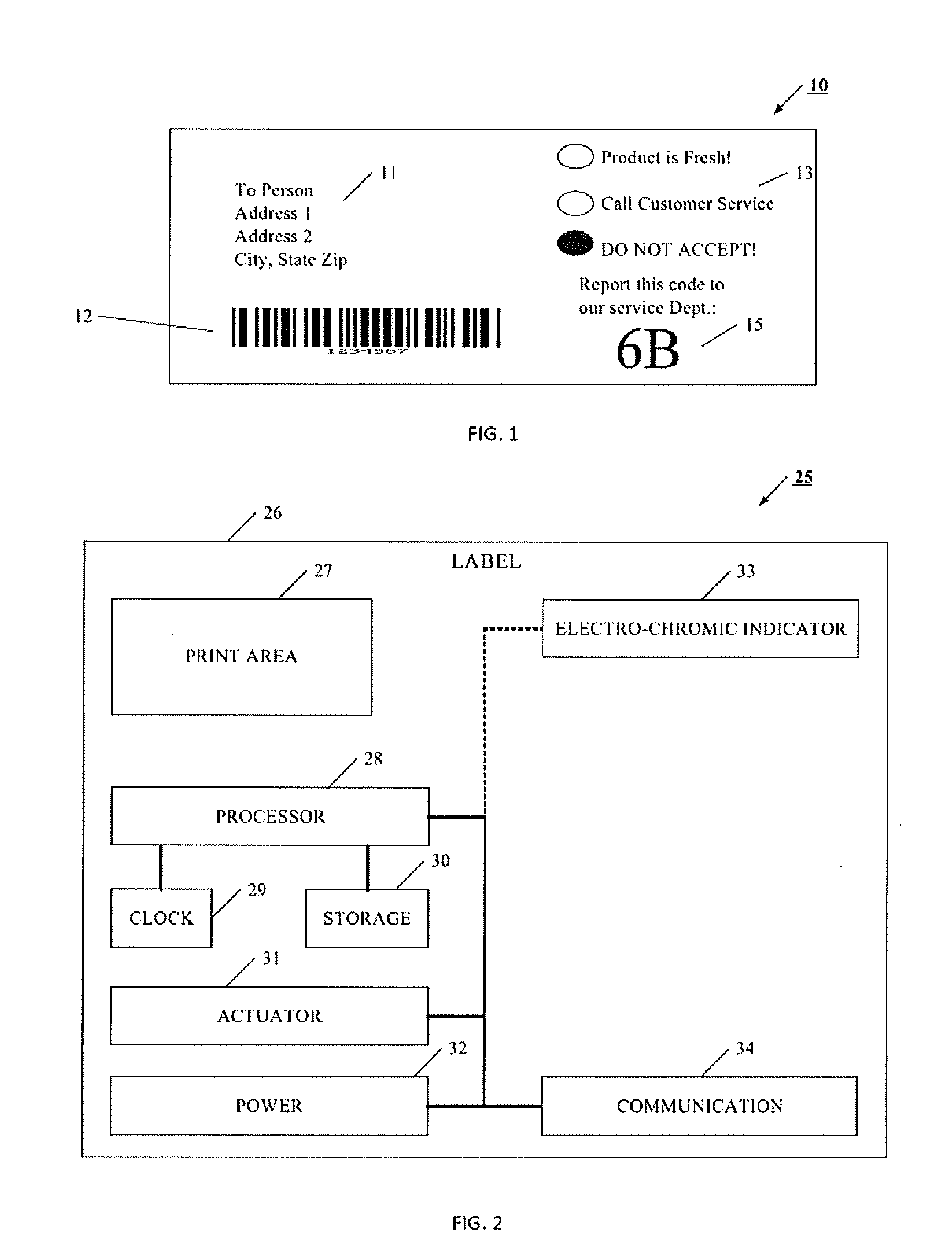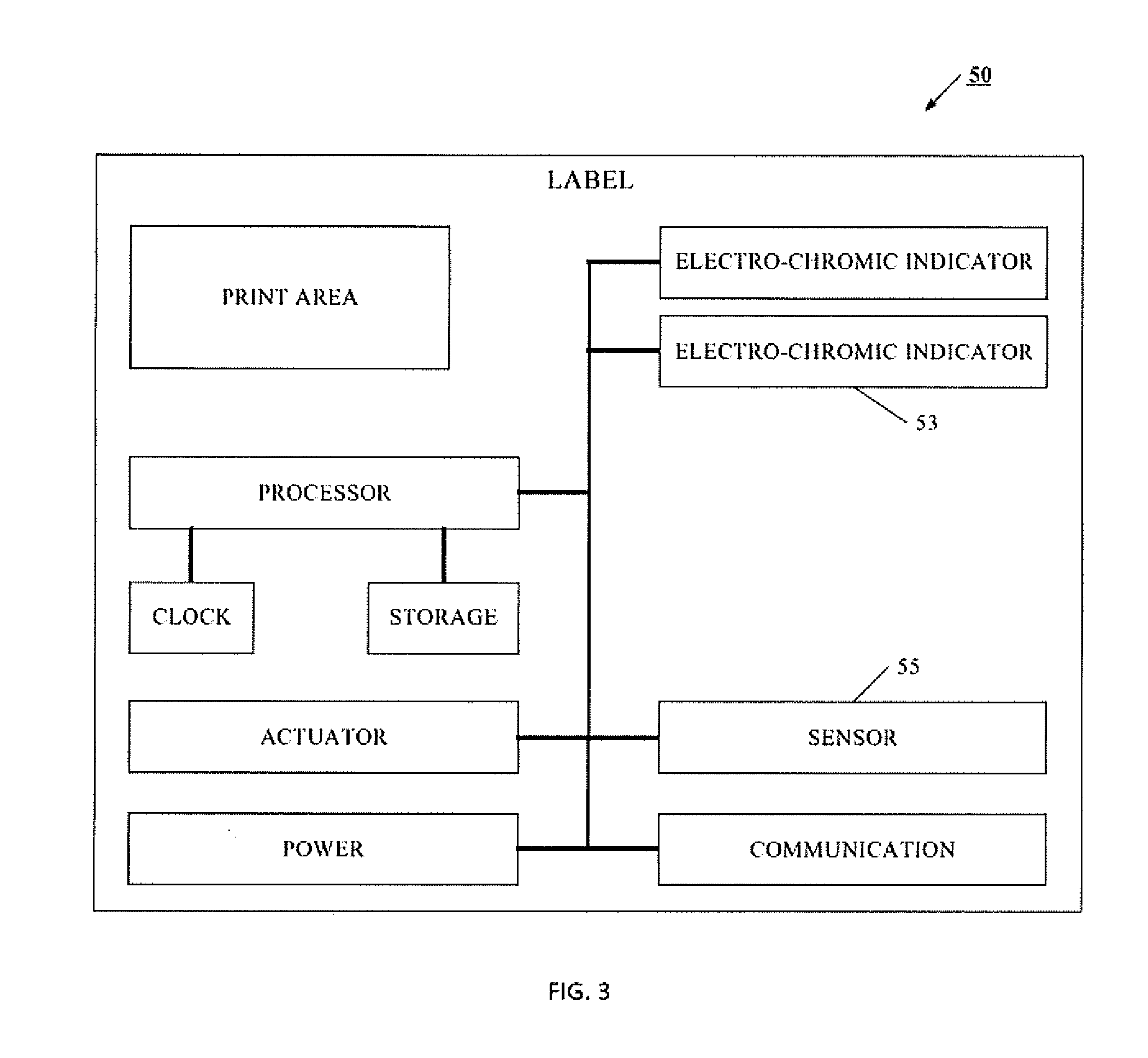Intelligent Label Device and Method
a technology of intelligent labels and labels, applied in the field of intelligent labels, can solve the problems of product spoilage or otherwise unusability, and achieve the effects of robust time determination, accurate and traceable time, and robustness
- Summary
- Abstract
- Description
- Claims
- Application Information
AI Technical Summary
Benefits of technology
Problems solved by technology
Method used
Image
Examples
example 1
Preparation of an EC Indicator with Opaque Electrolyte
[0119]Unless mentioned, all chemicals were obtained from Sigma-Aldrich (Milwaukee, Wis.). To a sure seal bottle fitted with a stir bar was added the PMMA (0.3 g, 15,000 molecular weight), acetonitrile (0.733 ml) and hydrophobic ionic liquid (0.49 g of 1-Butyl-1-methylpyrrolidinium bis(trifluoromethylsulfonyl)imide from Iolitee, Germany). The bottle was sealed and stirred at room temperature for two hours to form a slightly opaque colorless liquid. The bottle was transferred to a argon filled glove box and the 2,2′ bithiophene (redox monomer, 0.041 g) and lithium imide (0.14 g of Fluorad HQ115salt from 3M, St. Paul, Minn.) was added. The bottle was sealed and stirred for one hour to form a solution. To this solution was added the fumed silica (0.33 g) and TiO2 (0.3 g R996 obtained from DuPont, Wilmington, Del.) powders and the mixture stirred overnight. This resulted in a white liquid with a viscosity slightly higher than water (f...
example 2
Preparation of an EC Indicator with Clear Electrolyte
[0125]To a small sure seal bottle was added 0.3 g of PMMA (15,000 average molecular weight) and 0.733 ml of acetonitrile and ionic liquid (0.49 g of 1-Butyl-1-methylpyrrolidinium bis(trifluoromethylsulfonyl)imide. This was sealed and stirred for one hour to form a solution. To this was added 0.15 g of PMMA to give a total of 0.45 g of polymer. The mixture was stirred for two hours to form a solution. 0.033 g of fumed silica was added and again stirred for one hour. The bottle was placed in a fume hood under an argon atmosphere and 2-2′ bithiophene (0.041 g) and the lithium salt [HQ-115, Lithium Bis(trifluoromethanesulfonyl)imide, 0.14 g] were added. The flask was sealed and stirred for one hour to form a light green solution which after stirring for 24 hours turned dark green. Its viscosity was 87 centipoise, measured using Brookfield Model DV-III+ programmable viscometer at a shear strain of 960 s-1. This electrolyte was used mad...
example 3
EC Indicator with Opposing Interdigitated Electrodes on the Same Substrate
[0127]A transparent electrolyte was prepared by mixing 0.45 g of PMMA (15K MW), 0.033 g of fumed silica and 0.563 g of anhydrous acetonitrile. The mixture was stirred at 25° C. for two hours to form a translucent solution. Under an inert atmosphere was added 0.041 g of 2,2′ bithiophene, 0.014 g of lithium bis(trifluoromethanesulfonyl)imide and 0.8 g of 1methyl-1butylpymilidinum bis(trifluoromethanesulfonyl)imide. The mixture after stirring for two hours had a light green color.
[0128]A device was fabricated as described in Example 2 except that a patterned ITO electrode was used. The pattern was made using a laser etching process. In this process the ITO was etched from the substrate using an IR laser, where the width of the etched (or ablated) line was in the range of 30 to 50 microns. One could have also used UV or visible region lasers with etched widths down to less than 10 microns. A schematic drawing 535 ...
PUM
 Login to View More
Login to View More Abstract
Description
Claims
Application Information
 Login to View More
Login to View More - R&D
- Intellectual Property
- Life Sciences
- Materials
- Tech Scout
- Unparalleled Data Quality
- Higher Quality Content
- 60% Fewer Hallucinations
Browse by: Latest US Patents, China's latest patents, Technical Efficacy Thesaurus, Application Domain, Technology Topic, Popular Technical Reports.
© 2025 PatSnap. All rights reserved.Legal|Privacy policy|Modern Slavery Act Transparency Statement|Sitemap|About US| Contact US: help@patsnap.com



